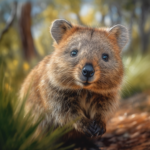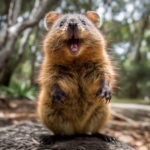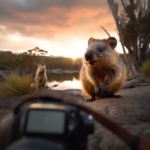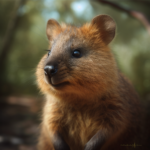The quokka, a small marsupial native to Western Australia, is an adorable and charismatic creature that has captured the hearts of many. But have you ever wondered what the quokka eats and where it fits into the food chain? In this article, we will explore the quokka food chain, examining the various organisms that play a role in its diet and those that rely on the quokka for sustenance. From plants to predators, the quokka‘s place in the food chain is a fascinating tale of survival and interdependence. So, let’s dive in and discover the intricacies of the quokka‘s diet and its significance in the ecosystem.
Key Takeaways
- The quokka food chain consists of plants, herbivores, and carnivores.
- Quokkas primarily feed on grasses, leaves, and bark.
- They are herbivores and play an important role in maintaining the balance of the ecosystem.
- Quokkas are preyed upon by predators such as snakes, birds of prey, and dingoes.
- Understanding the quokka food chain is crucial for conservation efforts and maintaining the biodiversity of their habitat.
Understanding Quokkas: The Smiling Marsupials
A. The Quokka: An Overview
The quokka, also known as the happiest animal on Earth, is a small marsupial native to Western Australia. These adorable creatures are primarily found on Rottnest Island, just off the coast of Perth, but can also be spotted in some parts of the mainland. Quokkas are herbivorous animals, meaning they have a plant-based diet consisting of leaves, grasses, and other vegetation.
Quokkas are known for their friendly and curious nature, often approaching humans without fear. They have become quite popular among tourists, who flock to Rottnest Island to capture a selfie with these smiling marsupials. However, it’s important to remember that quokkas are wild animals and should be treated with respect and caution.
B. Quokka Characteristics: What Makes Them Unique?
Quokkas have several unique characteristics that set them apart from other marsupials. Firstly, their most distinguishing feature is their adorable smile. The shape of their mouth and the positioning of their teeth give them a perpetually happy expression, earning them the title of “smiling marsupials.”
In terms of physical appearance, quokkas are small, measuring about 40 to 54 centimeters in length and weighing between 2.5 to 5 kilograms. They have a stocky build, with short legs and a long, tapering tail. Their fur is coarse and usually a sandy brown color, which helps them blend in with their natural habitat.
Quokkas are also known for their excellent climbing and jumping abilities. They can easily navigate through trees and shrubs, using their strong hind legs to propel themselves forward. This agility allows them to forage for food and escape from potential predators.
C. Why Do Quokkas Smile: Unraveling the Mystery
The reason behind the quokka‘s smile has been a subject of fascination for both scientists and the general public. While it may seem like they are constantly happy, the truth is that their facial expression is a result of their unique anatomy rather than their emotional state.
Quokkas have a natural upward curve to their mouths, giving them a permanent smile-like appearance. This feature, combined with their round, dark eyes, creates an endearing expression that has captured the hearts of many.
However, it’s important to remember that quokkas, like any other animal, experience a range of emotions. They have their own unique ways of communicating and expressing their feelings, which may not always be evident to human observers. It’s crucial to respect their boundaries and observe them from a safe distance to ensure their well-being.
In conclusion, quokkas are fascinating creatures with a unique place in the Australian wildlife ecosystem. Their herbivorous diet, friendly nature, and adorable smile make them a beloved symbol of Rottnest Island fauna. By understanding their characteristics and the mystery behind their smile, we can appreciate and protect these wonderful marsupials for generations to come.
The Habitat of Quokkas

A. Where Do Quokkas Live: Their Natural Environment
Quokkas, known for their adorable smiles and friendly demeanor, are native to Western Australia. These small marsupials can be found in a variety of habitats, ranging from coastal areas to dense forests. However, they are most commonly associated with Rottnest Island, located just off the coast of Perth.
Rottnest Island: A Quokka Haven
Rottnest Island is a haven for quokkas, with a population estimated to be around 10,000. The island’s unique ecosystem provides the perfect environment for these herbivorous animals to thrive. Quokkas are well-adapted to the island’s diverse plant life, which forms the basis of their diet.
Quokka Diet: A Plant-Based Affair
Quokkas primarily feed on a variety of plants, including grasses, leaves, and stems. Their diet consists mainly of vegetation found on Rottnest Island, such as coastal heath, sedges, and succulents. These plant-based food sources provide the necessary nutrients for the quokkas to survive and reproduce.
B. Quokka Göteborg: The Swedish Connection
While quokkas are primarily found in Western Australia, there is an interesting Swedish connection to these adorable creatures. The Universeum Science Center in Göteborg, Sweden, is home to a small population of quokkas. This unique exhibit allows visitors to observe and learn about these fascinating marsupials.
A Quokka Encounter in Göteborg
The Quokka exhibit at the Universeum Science Center provides visitors with a glimpse into the natural habitat of these Australian natives. The enclosure is designed to mimic the quokkas’ natural environment, complete with vegetation and climbing structures. Visitors can observe the quokkas as they go about their daily activities, gaining a deeper understanding of their behavior and lifestyle.
Conservation and Education
The presence of quokkas in Göteborg serves as an educational opportunity for visitors to learn about Australian wildlife and the importance of conservation. The exhibit highlights the need to protect these unique creatures and their natural habitats. By raising awareness about the quokka‘s role in the ecosystem, the exhibit contributes to the conservation efforts aimed at preserving biodiversity.
In conclusion, quokkas have a diverse range of habitats, with Rottnest Island being their primary stronghold. Their ability to adapt to different environments and their plant-based diet contribute to their survival. Additionally, the presence of quokkas in places like Göteborg allows people from around the world to appreciate and learn about these fascinating marsupials.
The Quokka Food Chain: A Detailed Examination
A. What Do Quokkas Eat: Their Preferred Diet
Quokkas, native to Western Australia and particularly prevalent on Rottnest Island, have a fascinating diet that reflects their role in the local ecosystem. These small marsupials are herbivorous animals, meaning they primarily consume a plant-based diet. Their food habits play a crucial role in maintaining the delicate balance of the island’s food web.
Quokkas have adapted to their environment by developing a preference for specific types of vegetation. They mainly feed on grasses, leaves, stems, and bark. Some of their favorite food sources include the leaves of acacia trees, grasses like kikuyu and buffalo grass, and various shrubs. These plant species are abundant on Rottnest Island, providing a reliable food source for the quokkas.
To supplement their diet, quokkas also consume fruits, seeds, and nuts when available. They are known to eat small quantities of succulent plants, such as pigface, which provide additional hydration in the arid climate. This diverse diet ensures that quokkas receive the necessary nutrients for their survival.
B. How Do Quokkas Get Their Food: Survival Tactics
Quokkas have developed several survival tactics to obtain their food efficiently. Despite being small and relatively slow-moving, they have adapted to their natural habitat and become skilled foragers. Here are some strategies they employ:
-
Nocturnal Feeders: Quokkas are primarily nocturnal animals, meaning they are most active during the night. This behavior helps them avoid the scorching heat of the day and reduces competition for food with diurnal species. By feeding at night, quokkas can access their preferred food sources without much interference.
-
Habitat Adaptation: Quokkas have adapted to their environment by becoming proficient climbers. They can scale trees and shrubs to reach higher foliage, expanding their food options. This adaptation allows them to access leaves and stems that other herbivores may not be able to reach, giving them a competitive advantage in the food chain.
-
Efficient Digestion: Quokkas possess a specialized digestive system that enables them to extract maximum nutrition from their plant-based diet. They have a large cecum, a part of the digestive tract where bacteria break down cellulose and other complex carbohydrates. This adaptation allows quokkas to extract nutrients from fibrous plant material that would otherwise be indigestible.
C. Quokka Fiender: Predators in the Quokka Food Chain
While quokkas have adapted well to their environment and have a diverse diet, they are not without predators. Several species pose a threat to these small marsupials, and their presence plays a crucial role in maintaining the balance of the quokka food chain. Some of the predators that quokkas face include:
-
Dingoes: Dingoes, wild dogs native to Australia, are known to prey on quokkas. They are skilled hunters and can pose a significant threat to the quokka population, particularly in areas where their territories overlap.
-
Birds of Prey: Various birds of prey, such as wedge-tailed eagles and ospreys, are natural predators of quokkas. These birds have keen eyesight and powerful talons, allowing them to swoop down and capture quokkas when they are vulnerable.
-
Introduced Predators: Unfortunately, the introduction of non-native predators, such as foxes and feral cats, has had a detrimental impact on the quokka population. These predators have fewer natural controls in place and can cause significant harm to the quokka population if left unchecked.
Despite the presence of predators, quokkas have evolved survival strategies to mitigate the risk. Their nocturnal behavior helps them avoid direct encounters with predators, and their ability to climb trees and shrubs provides them with escape routes. Additionally, quokkas have a high reproductive rate, which helps maintain their population numbers even in the face of predation.
Understanding the quokka food chain and the ecological interactions within their habitat is crucial for preserving the biodiversity of Australia’s unique wildlife. By studying the quokka‘s diet, survival tactics, and predators, researchers can gain valuable insights into the delicate balance of the ecosystem and implement conservation measures to protect these adorable marsupials.
Quokka Företag: The Role of Quokkas in Ecosystems

A. Quokkas as Prey: Their Position in the Food Chain
Quokkas, native to Western Australia, are small marsupials known for their adorable appearance and friendly demeanor. While they may be cute, quokkas play a vital role in the ecosystems they inhabit. One of the key aspects of their ecological significance is their position in the food chain.
As herbivorous animals, quokkas have a plant-based diet consisting mainly of grasses, leaves, and stems. They are considered primary consumers, as they directly consume plant matter. By feeding on vegetation, quokkas help control plant growth and contribute to the overall balance of the ecosystem.
However, quokkas are not only consumers but also prey for various predators. They face threats from animals such as dingoes, foxes, and snakes. Being part of the food chain, quokkas serve as a crucial food source for these predators, helping to sustain their populations.
The presence of quokkas in the food chain also influences the behavior and distribution of their predators. For instance, the abundance or scarcity of quokkas can affect the movement patterns and hunting strategies of predators. This interdependence between quokkas and their predators creates a delicate balance within the ecosystem.
B. Quokkas as Seed Dispersers: Their Ecological Role
Apart from being prey, quokkas also play a significant role as seed dispersers, contributing to the ecological dynamics of their natural habitat. As they move through their environment, quokkas inadvertently pick up seeds on their fur or in their feces. These seeds can then be transported to new areas, aiding in the dispersal of plant species.
Quokkas have a unique adaptation that enhances their effectiveness as seed dispersers. They possess a specialized gut that allows them to consume a variety of plant material, including seeds. This enables them to digest and pass seeds through their digestive system intact, increasing the chances of successful seed dispersal.
The role of quokkas as seed dispersers contributes to the biodiversity and regeneration of plant communities. By dispersing seeds to different locations, they help plants colonize new areas, expand their range, and maintain genetic diversity. This process is vital for the long-term survival and resilience of plant populations.
In addition to their ecological role, quokkas also contribute to the aesthetic value of their habitats. Their presence and behavior attract tourists and researchers, raising awareness about the importance of conserving these unique ecosystems.
In conclusion, quokkas play a multifaceted role in ecosystems. As prey, they occupy a position in the food chain, serving as a food source for predators and influencing their behavior. As seed dispersers, they contribute to the dispersal and regeneration of plant species, promoting biodiversity. Understanding and protecting the ecological interactions involving quokkas is crucial for maintaining the balance and health of their habitats.
The Plight of the Quokkas: Facing Endangerment

A. Why Are Quokkas Endangered: Threats and Challenges
Quokkas, known for their adorable smiles and friendly demeanor, are facing a concerning decline in population. These small marsupials, native to Western Australia, are listed as vulnerable on the IUCN Red List of Threatened Species. Several factors contribute to the endangerment of quokkas, posing significant threats and challenges to their survival.
Habitat Loss and Fragmentation
One of the primary reasons for the decline in quokka populations is habitat loss and fragmentation. As human development expands, the natural habitat of these animals is being encroached upon. Quokkas primarily inhabit the forests and coastal scrublands of Western Australia, with Rottnest Island being a notable stronghold for their population. However, urbanization, agriculture, and land clearing activities have resulted in the destruction and fragmentation of their habitat. This loss of suitable living space restricts the quokkas’ ability to find food, shelter, and mates, ultimately endangering their survival.
Predation and Introduced Species
Another significant threat to quokkas is predation by introduced species. Quokkas have evolved in isolation, making them vulnerable to predators that they have not coexisted with for thousands of years. Feral cats and foxes, introduced to Australia by European settlers, pose a significant risk to quokkas. These predators have a detrimental impact on the quokka population, preying on them and their young. Additionally, the introduction of herbivorous animals, such as rabbits and goats, competes with quokkas for limited food resources, further exacerbating their endangerment.
Climate Change and Environmental Factors
The effects of climate change and other environmental factors also contribute to the endangerment of quokkas. Rising temperatures, changing rainfall patterns, and increased frequency of extreme weather events can disrupt the delicate balance of the ecosystem. These changes can affect the availability of food sources for quokkas, making it harder for them to find sufficient nourishment. Furthermore, alterations in vegetation patterns and the loss of plant diversity can impact the quokka food chain, leading to potential imbalances in the ecosystem.
B. The Impact of Endangerment on the Quokka Food Chain
The endangerment of quokkas has far-reaching consequences for the quokka food chain and the overall ecosystem. Quokkas play a vital role in maintaining the balance of their habitat through their feeding habits and ecological interactions.
Herbivorous Diet and Plant-Based Interactions
Quokkas are herbivorous animals, primarily feeding on a plant-based diet. They consume a variety of vegetation, including grasses, leaves, stems, and bark. By feeding on these plants, quokkas contribute to seed dispersal, helping to regenerate the vegetation in their habitat. This interaction is crucial for the overall health and biodiversity of the ecosystem.
Nocturnal Feeders and Adaptation to Environment
Quokkas are primarily nocturnal feeders, venturing out at night to find food. This behavior allows them to avoid competition with other herbivores that are active during the day. Their adaptation to a nocturnal lifestyle ensures they have access to food resources without direct competition, promoting a more balanced food chain within their habitat.
Ecological Interactions and Survival Strategies
Quokkas are an integral part of the quokka food chain, interacting with both predators and prey species. As prey animals, they are a food source for predators such as snakes, birds of prey, and dingoes. Their presence in the food chain helps maintain the population dynamics of these predator species. Additionally, quokkas’ survival strategies, such as their ability to climb trees and swim, provide them with alternative escape routes from predators, further contributing to the intricate web of ecological interactions within their ecosystem.
In conclusion, the endangerment of quokkas poses significant threats and challenges to their survival. Habitat loss, predation by introduced species, and the effects of climate change all contribute to their decline. The impact of endangerment extends to the quokka food chain, affecting the delicate balance of the ecosystem. Understanding and addressing these challenges are crucial for the conservation and protection of quokkas and the preservation of their unique role within the Australian wildlife. Conclusion
In conclusion, the quokka food chain is a fascinating ecosystem that showcases the interdependence of various organisms in maintaining the delicate balance of nature. From the primary producers like plants and trees to the herbivores like quokkas, and finally to the top predators like snakes and birds of prey, each organism plays a crucial role in the survival and sustainability of the quokka population. The quokka‘s diet primarily consists of grasses, leaves, and fruits, which they obtain by foraging in their habitat. However, they are also known to opportunistically feed on insects and small animals when the opportunity arises. Despite their adorable appearance, quokkas are skilled survivors, adapting to the limited resources available on their island home. By understanding the quokka food chain, we gain a deeper appreciation for the intricate web of life and the importance of preserving these unique ecosystems for future generations.
Frequently Asked Questions
Why do quokkas smile?
Quokkas appear to be smiling due to the natural structure of their facial muscles. This “smile” is not related to their emotions but is a characteristic feature of their species. It has made them popular as the “happiest animal in the world“.
What is the role of the quokka in the food chain?
Quokkas are herbivorous marsupials and play a crucial role in the food chain. They consume plant material, aiding in nutrient cycling in their ecosystem. They are also prey for various predators, contributing to the ecological balance on Rottnest Island.
Why are quokkas endangered?
Quokkas are considered vulnerable due to habitat loss, predation by introduced species like foxes and cats, and human interference. Climate change also poses a significant threat to their survival.
What do quokkas eat?
Quokkas have a plant-based diet. They primarily eat leaves, grasses, and stems. They are nocturnal feeders and have adapted to get most of their water from their food, a survival strategy in their natural habitat.
Where do quokkas live?
Quokkas are native to small islands off the coast of Western Australia, the largest population being on Rottnest Island. They also inhabit some mainland areas, but in fewer numbers due to predation by foxes and cats.
How do quokkas get their food?
Quokkas are herbivorous and get their food by foraging for leaves, stems, and grasses during the night. Their strong jaws and teeth allow them to chew through tough plant material.
What are the main characteristics of a quokka?
Quokkas are small marsupials with a body length of 40-54 cm and a tail length of 25-30 cm. They have a stocky build, rounded ears, and a short, broad head. Their fur is thick and coarse, ranging in color from brown to grey.
What is the environmental impact on the quokka food chain?
Human activities and climate change have significantly impacted the quokka food chain. Habitat loss due to deforestation and urbanization has reduced their food sources, while introduced predators have increased mortality rates.
How has the quokka adapted to its environment?
Quokkas have several adaptations to their environment. They are nocturnal, which helps them avoid the daytime heat. They get most of their water from their food, a crucial adaptation to their dry habitat. They also have a unique ability to climb trees to escape predators.
What is the role of quokkas in the biodiversity of Australia?
Quokkas contribute to Australia’s biodiversity as unique marsupials found only in specific regions of Western Australia. They play a significant role in their ecosystems, both as consumers of plant material and as prey for various predators. Their existence is indicative of a healthy, balanced ecosystem.




